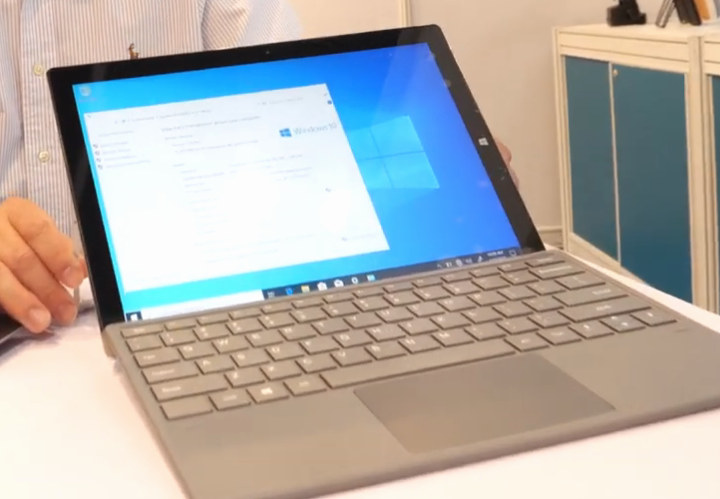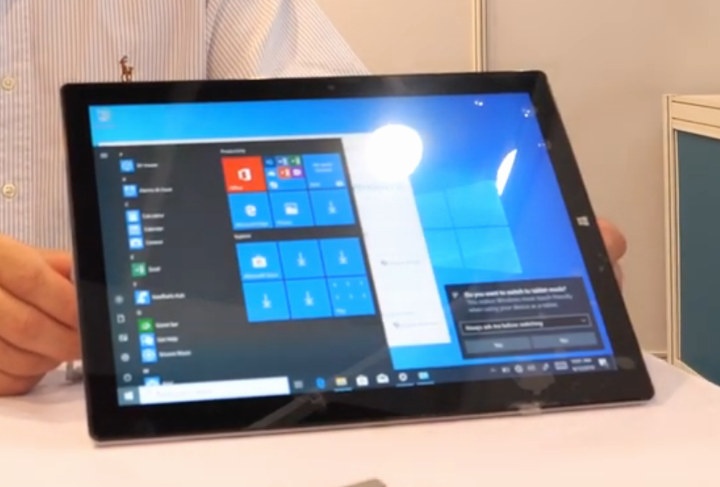Current Qualcomm based Windows 10 laptops are mostly interesting for people wanting all-day battery life and/or being always connected over 4G LTE, as they are still pretty expensive, and performance somewhat underwhelming, although Snapdragon 8cx processor should change that.
Chinese-based PiPo, known for their tablets, mini PCs and Arm Android laptops, is working on solving affordability of Arm Windows 10 laptop with their Snapdragon 850 2-in-1 laptop, heavily inspired by Huawei MateBook E 2019, and expected to sell for half the price or around $400.
PiPo 2-in-1 laptop preliminary specifications:
- SoC – Qualcomm Snapdragon 850 octa-core Kryo 385 Arm cores clocked @ up to 2.96 GHz with Adreno 630 Visual Processing Subsystem, Hexagon 685 DSP
- Systmem Memory – 8GB RAM
- Storage – 256GB flash storage
- Display – 12.3″ IPS display with 3000×2000 resolution, 10-point touch
- Audio – 3.5mm audio jack,
- Connectivity – WiFi 5 802.11ac/b/g/n + 4G LTE
- Camera – 5.0MP front-facing camera. 13MP rear camera
- USB – 1x USB type-C port for power, data, and DisplayPort Alt. mode
- Misc – Power and volume buttons
- Battery – 7.6V 5,000mAh battery
PiPo’s laptop runs Windows 10 Pro 64-bit Arm, but if you’re interested in an Arm Linux laptop that’s more powerful than PineBook Pro, there may be hope via aarch64-laptops project that’s supposed to support both Snapdragon 835 & 850 laptops. The project has not had much activity in recent months however.
I found out about this laptop in a Charbax video where the 2-in-1 laptop is showcased, and we are told the reference price will be less than $400.
Manufacturers often provide MOQ price (factory price) for their product, but in this case, I believe $400 is the expected retail price, as he mentions it will be much cheaper than to Huawei MateBook E that’s listed for around $565 (3,999 RMB).
The video also shows clamshell 13.3″, 14.1″ or 15.4″ versions, but they don’t appear to have designed Snapdragon 850 laptops based on those yet, and it will depend on demand. MOQ price (1,000 units) is expected to start around $250 for the 13.3″ model with WiFi only.

Jean-Luc started CNX Software in 2010 as a part-time endeavor, before quitting his job as a software engineering manager, and starting to write daily news, and reviews full time later in 2011.
Support CNX Software! Donate via cryptocurrencies, become a Patron on Patreon, or purchase goods on Amazon or Aliexpress. We also use affiliate links in articles to earn commissions if you make a purchase after clicking on those links.







How about a $280 SKU with 10Ah battery?
If only we can install linux on these laptop.
I have no doubt we will.
I run Linux on ARMv8 all the time. So, why shouldn’t you be able to install it?
Because of unsupported components? Or buggy/locked bootloaders? Even boards supposed to have support for Linux can be a pain.
>I run Linux on ARMv8 all the time.
Having it working so that a basic framebuffer works well enough for a virtual console and actually having something that works like a machine from the last decade with working audio, 3d and video decoding are two different things.
Who needs more than a terminal? 😀 Emacs ftw ^^
Emacs is not a terminal by default btw.
>Who needs more than a terminal?
k-pop music videos don’t look so good rendered in ascii or at 5 fps via a cpu blitted framebuffer..
The bootloader has to be unlocked for unsigned boot — something that hasn’t been a problem on most other WoS devices. Other than that it’s UEFI. From there on, you could go with either chromeos (https://www.youtube.com/watch?v=UGZCritrPJk), or go mainstream linux (https://www.phoronix.com/scan.php?page=news_item&px=Linux-5.4-ARM-Excitement) with some adreno tinkering on top. Give it some time and the tinkering will be unnecessary (e.g. https://lists.freedesktop.org/archives/dri-devel/2019-June/224000.html).
A battery s922x or s905x3 laptop would be interesting.
I’m always excited to see something with a less than 5 year old ARM Coretex design being made into a convertible or clamshell laptop. It’s always a shame that given how far behind ARM is in single thread integer performance, these companies continue to choose outdated ARM cores running at a fraction of the speed of a mobile phone, as the heart of a PC. They’re creating an impression that ARM cannot be even remotely competitive, which in turn affords them a market of people looking for absolute bottom-bin products which they can’t possibly make any money manufacturing.
If one of these companies would push ahead with an A77 design and deliver it before the end of 2021 (2 years after ARM made the IP available for fabbing) then they would stand out from the crowd and gain some mindshare, instead of being in the back of the also-rans.
ARM themselves should get behind this… it would behoove them immensely to change the perception that ARM = weaksauce when it comes to PCs. That would elevate their IP value so Apple will have to pay more for it when they eventually buy ARM out.
Outside of the server world it probably isn’t economical to build ARM’s latest cores into chips that would rival a recent i7 chip. Aside from that even if the Cortex A77 is a fantastic core you need all of the other IP need to make it a strong chip like memory/pci-e controllers that aren’t garbage… and if you can get all of that together you still don’t have Fusion 360, Steam and so on that people actually want to run on their $1000+ machine.
All the x86 proprietary software needs to be run in emulation. Cores are fast enough nowadays to do this. When you see the amount of applications involving interpreted languages or sub-optimal byte code behind the curtains with nobody complaining, it’s certain that the desktop has been ready for emulation for about a decade.
>All the x86 proprietary software needs to be run in emulation.
I don’t think anyone is going to want to run Fusion 360 with a 50% speed penalty.
>When you see the amount of applications involving interpreted languages or
>sub-optimal byte code behind the curtains with nobody complaining,
People are also happy with slow mobile SoCs for a lot of things. It doesn’t mean someone is going to buy your “performance” ARM machine get hit by having to emulate everything they want to run, not be enable to upgrade the memory because it’s soldered in or the memory controller only works with one specific brand of DIMM, not be able to use a GPU that is supported by the intensive applications they purchased the machine for and so on and be happy about it.
My prediction is that consumer “high performance” machines will be gone before anyone really rivals Intel.
Games, CAD etc are increasingly becoming SaaS and once everything you want to use only uses the local machine a dumb terminal it’s performance barely matters anymore.
> I don’t think anyone is going to want to run Fusion 360 with a 50% speed penalty.
It depends “50% compared to what”. Plenty of people seem to be fine these days with CPUs at 1.8 GHz or so, throttling after a small sprint of 5s. And most people don’t use such heavy software, just like most laptop users are not necessarily developers who need a fast CPU. People I commonly see with a laptop even use Windows and do stuff I personally have absolutely no use for. Some of them use even slower tablets and are fine with this. These ones are the perfect target for emulation.
>It depends “50% compared to what”.
If you are working on a big project in Fusion 360 and everything is emulated and running on a weak GPU you’ll notice it. The benchmarks for Windows’ x86 emulation aren’t great.
>Plenty of people seem to be fine these days with CPUs at 1.8 GHz or so,
You seem to have missed the point I was making. Yes lots of people are happy with some years old ARM core running at sub 2GHz and that’s exactly why you won’t see many of the ARM vendors going out of their way to fab anything better as it simply isn’t worth their time.
No one is going to buy a $1000 ARM laptop even if the instructions are all free range and organically farmed when they can pay about the same and get a lenovo with an i7 and nvidia graphics that’ll run all of the stuff they actually want, has storage that operates faster than a usb thumb drive, will take 64GB of RAM and so on.
For the average office drone working on company e-mails or memos at the hotel, i3 or i5 performance is good enough. Low cost, lightweight and long battery life are more important in that market segment. There’s potential here to sell a lot of these. You can make money with small profit margins if the total sales are high enough.
“That would elevate their IP value so Apple will have to pay more for it when they eventually buy ARM out.”
ARM has already been bought; by SoftBank
This is actually a very “in your face” Surface Pro clone. Even the aspect ratio is the same.
No Bluetooth? Rats! I’d hate to use a dongle.
I’m not sure about that. They may simply not have listed Bluetooth on the sticker on the back of the laptop.
Even more Snapdragon 850 laptops from China as Weibu showcases 5 models at the HK electronics fair.
https://www.youtube.com/watch?v=BR4YQvMApGo